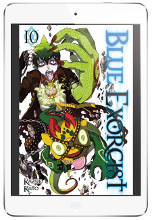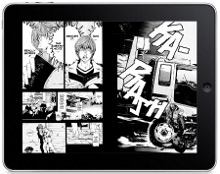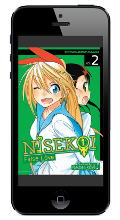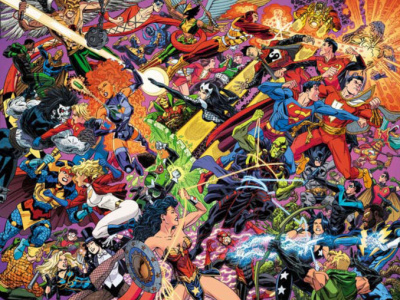 ICv2 sat down with Viz Media CTO Gagan Singh to talk about the digital landscape for manga and Viz’s place in it, which is rapidly evolving. This week, Viz titles are now beginning to appear in Apple’s iBookstore, the latest in a major expansion of digital availability for Viz manga titles.
ICv2 sat down with Viz Media CTO Gagan Singh to talk about the digital landscape for manga and Viz’s place in it, which is rapidly evolving. This week, Viz titles are now beginning to appear in Apple’s iBookstore, the latest in a major expansion of digital availability for Viz manga titles.In Part 1, we talk about the digital ecosystem for Viz content, the roles of the different channels, and the reasons for key decisions in moving to digital. In Part 2, we talked about the day and date release with japan, the competition with pirated content, and the future of digital manga.
Can you tell us what you were doing before you came to work for Viz?
I have a long and convoluted background. I worked on Wall Street and went to work for a company called Joost founded by the Skype duo. Subsequent to that I founded my own company called West Side Labs where we started off building Viz’s anime streaming destination site, VizAnime. We built the applications in collaboration with Viz for iPad, iPhone, built VizMmanga. And then when Ken Sasaki became CEO he asked me to join the company and help him expand the work that we had already been doing for quite some time together.
Did you bring your team with you?
Yes, Viz acquired West Side Labs and we’ve been a part of the company ever since.
How many people was that?
We had four people at the time of the Viz acquisition. I had some other assets in Japan that we liquidated just prior to coming on board.
We’re interested in how you see the different parts of the Viz digital strategy. Starting on the manga side, what do you see as the role of the Viz manga app?
Two and a half years ago (whenever we built the first version of it), the main reason for going into it directly instead of with a partner was that none of the readers were ready for a right to left graphic novel experience. You heard about digital starting to gain market share on print but it wasn’t possible in the manga space. Right to left is a unique experience. Interestingly enough they had it in most of the big device manufacturers and app guys who had products in Japan, but it just didn’t translate. You couldn’t do it right to left in the United States for whatever reason. That’s how it started off and we continued to expanding it from iOS to Android. Web was an essential element of it from day one.
Today a lot of those are pretty mature. A lot of devices have format support. We just made an announcement with Amazon Kindle starting the first of this month, which has great support for it. Our content is available on Kobo. So now is a good time for us to revisit the role of the platform along side our publishing partners.
Having said that, we recently did a re-invent of our corporate website, in March of this year. The big learning that came out for me, having interviewed a number of people to understand what the purpose of a destination site for something like Viz would be, most of our fans said, "We see you as a catalog. We come to you for advice. You are the trusted source to tell me what to read next." Or, "I just finished reading this book, what else do you have?" So we started building our entire ecosystem around that theme of "we are still a trusted source."
We don’t necessarily want to compete with our partners, but we do want to offer a value proposition if our fans choose to say, "I’m just a manga reader and I have 80, 90, 100 percent of my content on this site," and choose to keep coming back. But at the same time, if you want to go to Amazon and get it cheaper on Kindle, we’ll encourage you and support that. I don’t have any intention of directly competing with our partners, but at the same time, the platform is pretty mature. We have nearly every feature that we feel like our fans would want. We continue to have people come in and make purchases off our site and off our devices. I haven’t seen that go down as we sign more deals with third party partners, so there’s no reason for us to take that away. Eventually, in five or 10 years as the devices become more mature and reading patterns on the digital side get more solidified that might be the time to take a look at it. I don’t feel any urgency to say that now that we have all these other devices we should shut it down.
In addition to the right to left problems, were there other format or reader experience goals that you were trying to address?
Our artists have a lot of say through their publishers, our licensors, in setting the right experience for the comic book in digital. When we started no one really had seen manga play out. Japan had manga on the 3G K% phones for the last 10 years.
That was panel by panel?
Yes, and the reason it was panel by panel is Japan had 3G connectivity starting in 2001 and 2002, so you could download large volumes of data on your devices, but the devices had very low resolution. You could not get a full page even on a single portrait view on a small K5 phone. You could get the data pretty quickly, but the reading experience was very poor. You didn’t have the pinch and zoom capability so the only way to read it was panel by panel at the time.
So when we started off, we had a lot of restrictions and we continue to have in many respects. Spreads was a big consideration. There was a lot of education that went on on both sides of the ocean. Our licensors are very sophisticated now. They have most of their content on Kindle and other devices so they’ve become a little more understanding, and we haven’t had to change our core reader since we launched it. They were satisfied with it, our fans were satisfied with it, so we haven’t really touched something that seems to be working so far.
Amazon didn’t have a manga storefront two and half years ago when we started off. A lot of these vendors are now starting to make a push because they see comic books and graphic novels as a growth category. We seem to be getting a lot more love than we did two years ago. And that’s helping the entire ecosystem.
I was sitting on an airplane yesterday and the person on my left had a Kobo and the person on my right had a Kindle and I couldn’t resist asking how did you end up with this device? You’re an iPhone user, why didn’t you just go out and get an iPad? People somehow associate reading with these devices and they enjoy the experience and that’s great. We’re happy to be on any platform anywhere the demand is.
I’m not even married to print versus digital. As an officer in the company it is my interest to first and foremost make sure the product is available to all readers. And if you’ve chosen to give up your print book and go buy a Kobo, or a Kindle or an iPhone or iPad, then I want to make sure you have the content available to you. If you are someone who has given up reading on the Web illegally and want to buy a print book, I want to make sure that we can direct you to the right places to make that acquisition, so that was a big part of our Website redesign and development.
And our affiliate revenues have gone off the charts because people are coming in and discovering more content and then going off to our partners, whether it’s Amazon or Right Stuf or any of these places. We are referring traffic to them. You come to our Website and we refer to them, which to us is not so interesting as a revenue source as it is more of an indicator of the interest that people are expressing in our content and then going off and making purchases. You can measure it--it’s not traffic, it’s not page views, it’s actual revenue that we produce by streamlining the discovery process for our content.
Do you have anything on the Viz site to facilitate the discovery process?
Absolutely. We’ll continue to get better at it. We collect an enormous amount of data in terms of what pages were viewed, what people actually read, and we continue to fine-tune that. We’re happy to share that with our partners as well. The last conversation I had with [the Nook people], I had some charts and said, “here’s the crossover for these series, we think you should promote these on your site.” We have some very detailed metrics on actual purchases that people made and I can tell you directionally people who bought this series went on to buy three other ones. And not all of them are intuitive.
My ideal down the road would be when you come to the storefront, we already know who you are, we know what kind of purchases you make, so the store front should be customized for you.
Right now on an iPhone, can you read panel by panel?
You zoom in and zoom out.
Since you had already crossed the bridge of displaying manga in Japan panel by panel, why is that a bridge that won’t be crossed here?
In my view it’s really about user demand. I read through every single reader feedback email that we get across our properties. In the last three years I might have gotten two emails out of tens of thousands saying "I want panel by panel."
So the zooming doesn’t appear to be a barrier?
I think part of it is the resolution of these screens is becoming so high and it’s less bothersome and less straining on your eyes, at least through the readers. But if I start seeing those requests, we’ll implement it.
It was a big topic of conversation when we decided to build version one of the application and actually our licensors were not too keen on going panel by panel. Alvin [Lu] and I had long-standing conversations on whether we should do panel by panel and we made a decision not to do it, and if there is demand and fans ask for it, then we’ll go ahead and add it. Our fans are not shy about letting us know what they would like. It hasn’t been a big issue.
Click here for Part 2.










